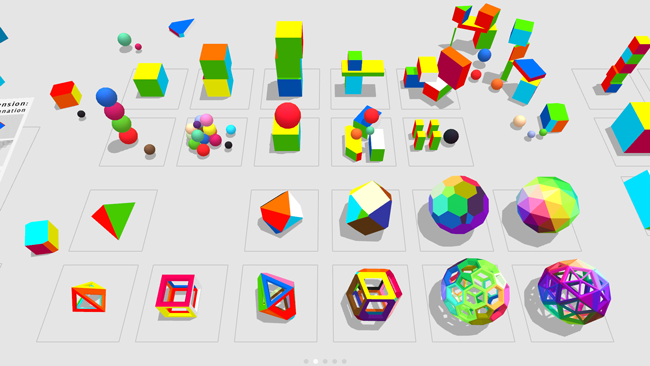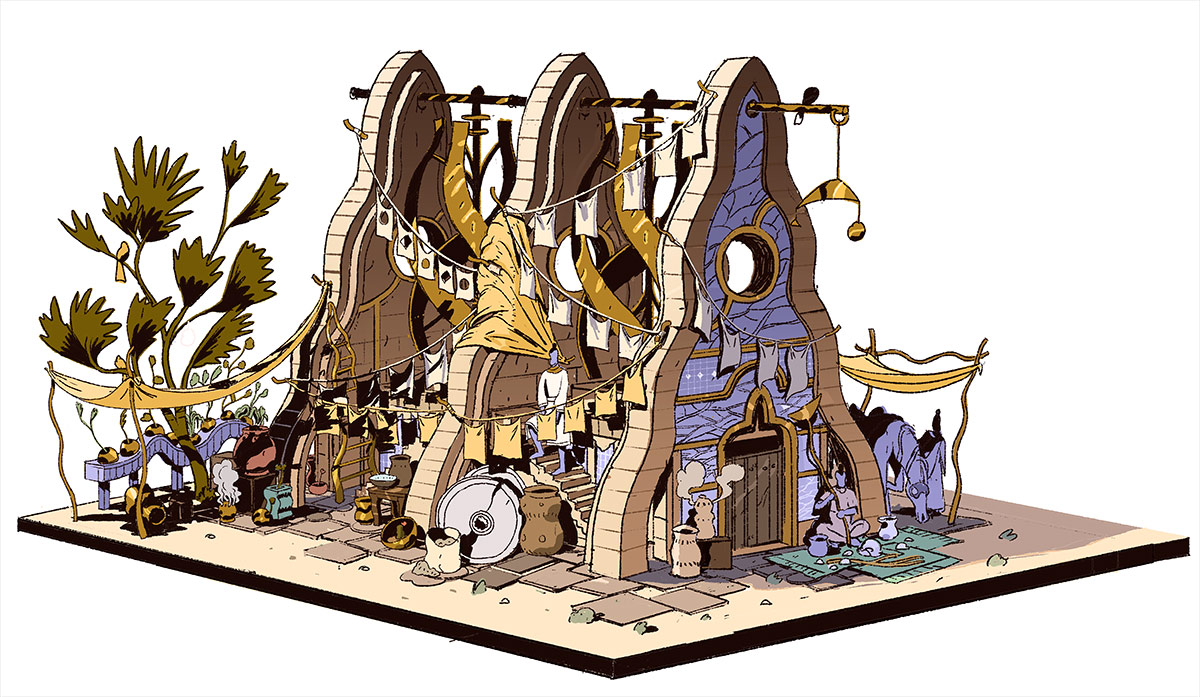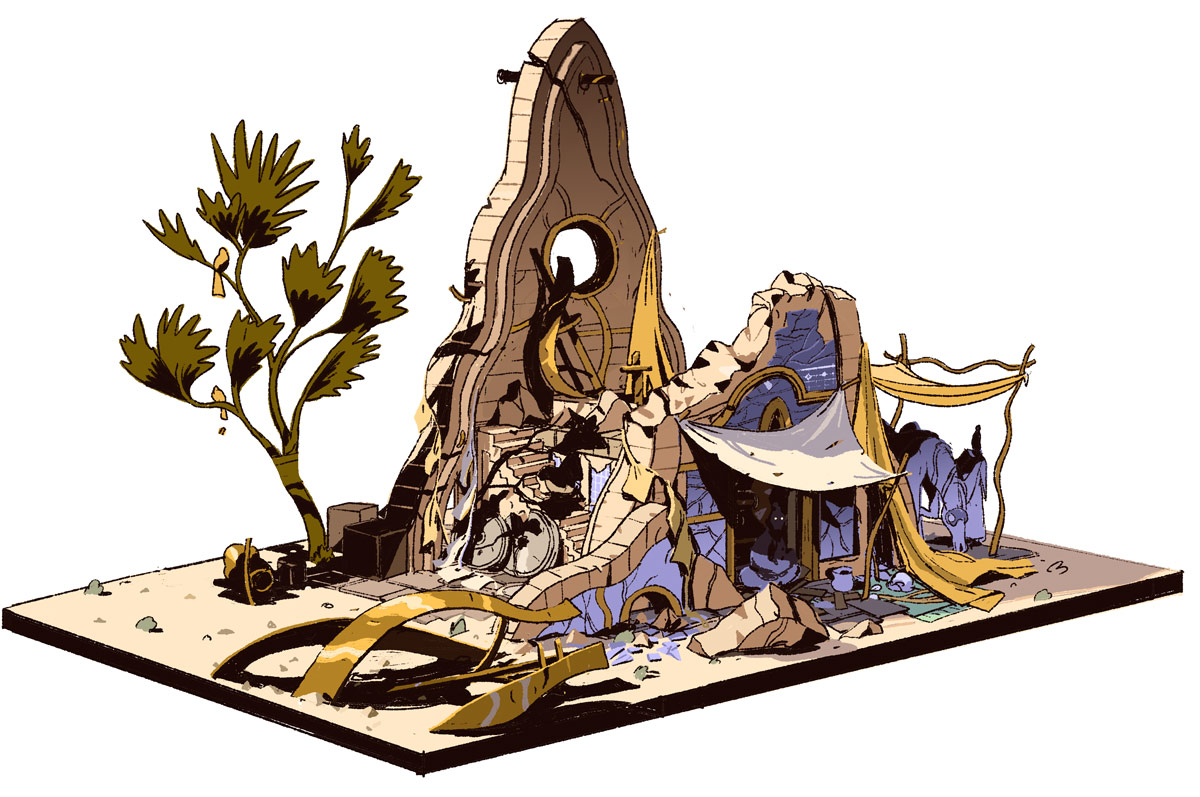So I have been working on Miegakure for a long time now, and I have created and accumulated many cool 4D things of all sorts. I think it’s about time that I share some of them, so…
Surprise! Today I am releasing something!
The History of 4D Toys
Near the very beginning of Miegakure’s development, someone joked I should do a “4D physics engine.” Then a year or so later I had gathered enough knowledge (especially in geometric algebra) that it was a possibility. So I made one for fun, and kept working on it on the side. It evolved into a 4D physics-based toy box that you can get right now, for iOS (Multitouch & Accelerometer) and Steam (both VR (Vive) and Mouse/Keyboard).
Basically it turns out the rules of how objects bounce, slide, fall, spin and roll around can be generalized to any number of dimensions, and this toy lets you experience what that would look like.
My initial goal in making this was to have a ton of fun inventing the math for it. At first I was skeptical it was going to be possible at all, but in the end the mathematics fit together so well.
I was only planning to use 4D physics a little bit for Miegakure as a purely aesthetic component, since dynamic physics is a bit too unpredictable to make good puzzles with. But then I started thinking about making a stand-alone iOS toy to play with 4D objects, to take full advantage of the physics. At first it was very simple and based around the idea that in 4D you can have interesting new dice shapes like a perfectly symmetrical 600-sided die, or a 4D hypercube die with 8 faces (each of them a cube). But I kept adding new shapes like hyperspheres, etc… and it got out of hand, so the dice theme didn’t fit anymore, and I named it simply “4D Toys.”
The website (4dtoys.com) has more info on it!
More details about the design of 4D Toys
Undirected 4D Play
4D Toys doesn’t take you through carefully-constructed successively harder challenges the way Miegakure does. It’s just 4D shapes, as if you were a very young kid again and given a box of wooden toys. Since the toys are 4D, that’s sort of true: you have no experience playing with 4D shapes.
Play is undirected and we don’t expect a child to come up with verbal realizations of what they are doing. They can learn about making stacks, and gravity, and fitting shapes into holes, and that could form the foundation for future, verbal, learning. Alternatively, one can just look at how pretty it is, like the waves rolling down the ocean, or the intricate swirling patterns in a fire.
It’s so exciting to me to see a pile of hypercubes or a rolling 120-cell. Most representations of a fourth dimension are so abstract (a spinning bundle of lines) and my work has been to get away from that. It’s the first time anyone has seen these objects as physical objects that bounce and roll and can be grabbed!
Side project
4D Toys was a very fun side project. It uses the same engine as Miegakure, and many improvements I made to it have hugely benefited Miegakure. For example, I built a lot of the complex 4D collision detection code used in Miegakure for 4D Toys. I also came up with many ideas for Miegakure levels and scenes while playing with 4D Toys.
Designing how to present 4D Toys
After I made it, I had to come up with a metaphor for what it was. Miegakure players know it is a puzzle-platforming game, so if they’ve played one before it sets a frame for the interaction, and the game can spend less time explaining everything and focus on the new stuff. They know how the game teaches things.
But 4D toys cannot rely on this well-known format. My goal was to strongly imply that it is not supposed to teach you in the way a puzzle-platformer like Miegakure does, but instead that it may only teach in an intuitive way. I came up with the idea of a box of toys, so the “menu” could be toys laid out on the floor, and you pick one and play with it, then come back to the menu.

However unlike a real toy box I have to first teach players how to manipulate the shapes a little bit. So I made a short tutorial that you have to play initially. The only thing that players really need to know besides the basic interactions is how to get back to the 4D shapes if they loose them into the fourth dimension. It’s fascinating to me that the tutorial teaches exactly that, even if a player has no idea what they are doing. Once the tutorial is complete almost all the shapes are available to play with.
I also wanted to explain, non-verbally, this idea of a 4D toy box, so we also put a small comic strip that shows how someone might end up with such a toy box. I like how subtly this idea is communicated. By the way, Kellan Jett (who is doing concept art for Miegakure) did the amazing art for it.

(By the way, for the VR version it is recommended to be on floor when playing!)
Adding an optional verbal explanation
I wanted to stop there and just give out a mysterious box of toys with barely any instructions, but playtesting revealed that some people really wanted to know more about how the shapes and how the fourth dimension worked and what they were seeing.
I think that while kids are fine playing with toys without fully understanding them, as we get old enough we start to ask “why?” when we discover something new… and as much as I like non-verbal learning, I didn’t want to leave these “why?” questions hanging in the air. If I manage to make you interested, why wouldn’t I try to answer these questions if I can? So I decided to add an optional interactive “Interactive Explanation” that takes you step by step through what the fourth dimension is, how a 2D being would experience the third dimension, and by analogy how a 3D being would experience the fourth dimension. This provides the beginning of an answer, and the toys become even more beautiful if you understand just a tiny bit more. There are also optional questions marks in certain scenes you can click on to get more info.

The interactive explanation could stand and be interesting on its own. It is very verbal, as opposed to the toy itself, which is totally non-verbal and freeform. While I wanted to get away from verbal learning because it is so often done poorly and takes you away from the experience, it is interesting to think about when verbal communication is appropriate and when it isn’t. In this case I think it is good that the explanation stands next to the experience itself and can be ignored. Interestingly, Miegakure sits sort of in-between these two extremes: it is goal-oriented and directed and has words, but it very intentionally never verbally teaches you about the fourth dimension or how to solve its puzzles.
Interaction method
Like I mentioned before, a problem that comes up when you are a 3D being playing with 4D toys is that they tend to disappear into the fourth dimension. A friend intuitively suggested a scrollbar to move along the 4D, and that seemed like the simplest way to solve the problem. Also this way we can display the extent of each shape in the fourth dimension and that allows players to very quickly find shapes when they lose them. Note that this is different from Miegakure’s mechanic of rotating the player’s slice. Miegakure’s rotation mechanic is necessary since the avatar would hit invisible walls if they could move in a direction they can’t see: 4D Toys does not have this problem since there is no physical avatar. Aside from the fact that both Miegakure and 4D Toys are 4D, the experience of playing each is completely different and complementary!
Final words
Anyway! It’s a thing. You can get more info about it at 4dtoys.com.
It is out now for iOS and Steam (both VR (Vive) and Mouse/Keyboard).
I am excited to release something, anything (!) and see how it goes and learn from the process. While I plan to add things to it when I feel like it, my focus is on Miegakure’s development. Please enjoy!














